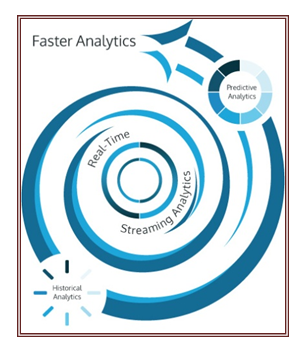Internet of Things is a new concept wherein everyday objects can identify other devices and communicate with each other over the Internet. Using the sensor or wireless technologies, or QR codes, they gather data and take action on that data across a network. Simply put, the Internet of Things is the future of technology that can make our lives more efficient.
The IoT is significant because a physical object can represent itself digitally and connect to other objects and database data. Using this information, they act in unison to take action accordingly.
Understanding IoT Data Analytics
The IoT is more than just a convenience for consumers. It offers new sources of data and business operating models that can boost productivity in a variety of industries such as Healthcare, Manufacturing, Retail, Telecommunications, Transportations, Utilities, and more.
The advancements in data analytics has made it move from the regular activity of monitoring the existing conditions and data for evaluating thresholds.
Internet of Things analytics (IoT analytics) refers to analyzing and examining the data obtained by the Internet of Things. The vital components which help in the collection and storing of IoT data are sensors, network end devices and other data storing and transmitting equipment, after which analysis is performed.
Benefits of IoT analytics
IoT analytics offers the capability to combine operational information with data from IT systems and deliver intelligent analytics to those stakeholders who need it the most. It can be applied to industrial automation, mobile apps, cloud solutions and hardware development, among other things. Thus, it is involved in-depth market analysis, general trends, economic state and forecasting of a product’s life cycle. It empowers organizations to integrate, transform, and manage the machine and sensor data in a Big Data environment. It also allows the Big Data to blend in with data from traditional information systems.
- It helps in outage management, predictive marketing, analysis, and maintenance.
- Better customer interaction, faster analysis, fraud detection,
- Monetize data assets and bring visibility to customers
- Streamline your data and drive operational intelligence
- Prepare, model, and explore semi-structured and unstructured data sets
- Native connectivity to leading Hadoop distributions, NoSQL stores, and analytic databases
- Blend sensor and machine data with data from data warehouses, enterprise applications, social media, and more
- Uncover meaningful patterns in equipment and device data with powerful machine learning and data mining tools
Some common examples the impact Internet of Things has on our lives. It is the result of how much economic benefit we can derive from analyzing the IoT data streams.
- They are used to provide intelligent transport solutions to speed up traffic flows, reduce fuel consumption, prioritize vehicle repair schedules.
- Smart electric grids which connect to renewable resources, improve system reliability and charge customers based on smaller usage increments.
- Machine monitoring sensors diagnose and predict pending maintenance issues, out of stock scenarios, and even prioritize maintenance crew schedules.
- Data-driven systems are being built into the infrastructure of “smart cities”, making it easier for municipalities, law enforcement and other programs run more efficiently.
- You can even get an alert from your refrigerator reminding to shop for milk.
- Remotely control your home security system, locks and thermostats based on your preferences.
To know more about Internet of Things and Data Analytics, you can contact us at info@sysfore.com or call us at +91-80-4110-5555

